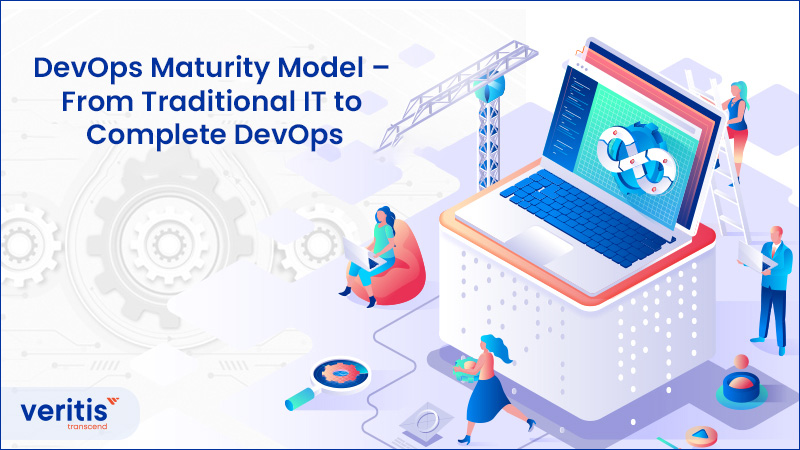
DevOps has transformed the traditional IT industry by changing how teams operate and collaborate in the automation process chain and collaboration workflow. By now, most organizations will have implemented some level of the DevOps maturity model in their software journey.
While some are in the process of understanding DevOps’ impact, others have yet to realize the full potential of the DevOps maturity model. However, the most common misconception around DevOps adoption remains, i.e., ‘understanding it as a journey or a destination.’
The DevOps Maturity Model delineates a structured framework for organizations to evaluate and enhance their DevOps capabilities. It commences with the Initial Phase, characterized by the predominance of traditional IT practices, minimal automation, and isolated, siloed teams. Progressing to the managed phase, organizations begin adopting fundamental DevOps principles, implementing version control systems, and automating select aspects of the deployment process.
As organizations transition to the defined phase, they deploy more sophisticated CI/CD pipelines, adopt Infrastructure as Code (IaC) for consistent and repeatable environment configurations, and cultivate enhanced collaboration between development and operations teams.
Advancing to the measured phase signifies a higher maturity level, where organizations establish comprehensive metrics and key performance indicators (KPIs) to assess the efficacy of their DevOps practices. This phase is marked by continuous monitoring and iterative feedback loops, enabling teams to make data-driven decisions to optimize their processes.
Finally, the optimized phase represents the pinnacle of DevOps maturity, where continuous improvement and innovation are the norm. DevOps frameworks are deeply ingrained within the organizational culture in this phase, emphasizing scalability, security, and resilience.
Automation is extensive, and teams are committed to continuous experimentation and process refinement to maintain a competitive advantage. The DevOps Maturity Model thus offers a robust framework for organizations to systematically advance their DevOps practices systematically, achieving superior efficiency and performance in software delivery.
This is what the ‘DevOps Maturity Model’ precisely speaks about!
Understanding DevOps Maturity
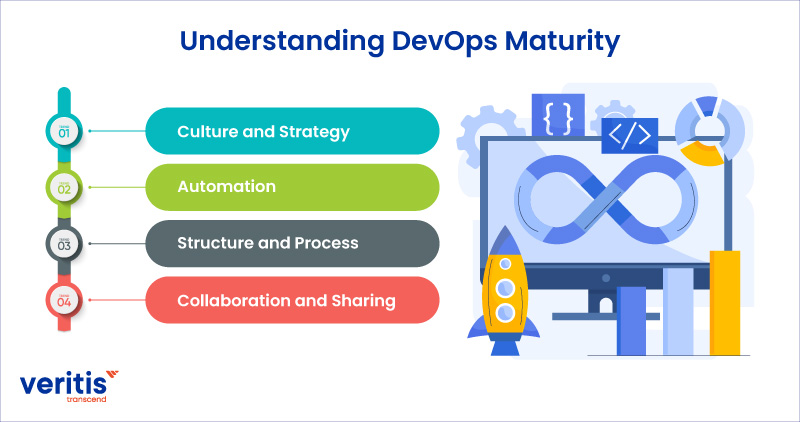
By definition, DevOps Maturity is a model that determines an organization’s standing in the principles of the DevOps collaboration journey and decides what more needs to be accomplished to achieve the desired results with the DevOps toolchain.
Understanding DevOps automation adoption as a continuous journey, not a destination, is crucial to achieving the DevOps maturity model. Most DevOps monitoring solutions are compatible with on-premise, cloud, and containerized infrastructure, ensuring a smooth DevOps transformation culture shift process.
The DevOps maturity model determines growth through continuous learning from both team and organizational perspectives. The more capabilities and skills, the more ability to handle issues of scale and complexity.
As the experts recommend, the organizational DevOps maturity model can be gauged by their abilities in the following four areas:
As the experts recommend, the organizational DevOps maturity model can be gauged by their abilities in the following four areas:
1) Culture and Strategy
DevOps culture shift must be understood as an approach that brings together different teams, driving them towards a common objective. Transitioning to the DevOps operating model means transforming the organization’s operating culture backed by policies and automation process frameworks. So, proper planning and a perfect strategy are needed to execute agile development.
2) Automation
DevOps Automation is key to continuous delivery and deployment tools in the DevOps collaboration process. By automating repetitive tasks, the automation process eases development, testing, and production in a DevOps Continuous integration/continuous delivery cycle, thus saving time and enhancing resource efficiency.
3) Structure and Process
Modern-day IT functioning is process-oriented and involves processes across all stages of the Software Development Life Cycle (SDLC). This has advanced in a DevOps containerization environment, where every stage is a set of procedures aligned with corporate policies and business objectives.
4) Collaboration and Sharing
This is the most critical aspect of the principles of the DevOps culture shift. Collaboration and sharing are essential to the DevOps maturity model, and teams (in the exact location or a different location) will need to calibrate the toolchain and resources to achieve common goals and objectives.
According to Forbes research, organizations commonly find themselves in one of the following stages as part of their DevOps automation model journey:
- Unconscious incompetence: Organizations fail to understand DevOps challenges and its advantages
- Conscious incompetence: Organizations still see siloed processes after 12-18 months of DevOps journey with some automation in agile development.
- Conscious competence: After four years of DevOps adoption journey and successful automation, organizations focus on collaboration across teams and streamlining the sharing mechanism
- Unconscious competence: Here, organizations are all set with structured frameworks, in-depth collaboration, and a concrete automation process for effective sharing.
Useful link: Demystifying MLOps vs DevOps: Understanding the Key Differences
What Makes a DevOps Maturity Model?
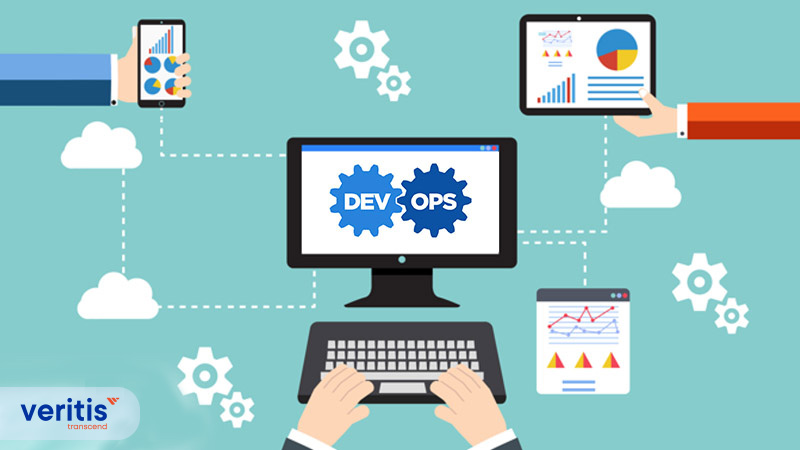
A perfect DevOps maturity model determines DevOps maturity in three ways:
- DevOps Maturity Assessment of the current state of capabilities
- Identifying areas of improvement
- Outlining steps to achieve desired DevOps assessment goals
In line with these three steps, the DevOps maturity block verifies maturity in building, deploying, and testing stages across application, data, and infrastructure levels:
1) DevOps Maturity for Application – Determines DevOps maturity by the ease in code movement from Development to the Production phase. Achieving this requires building, testing, code coverage, security scans, and monitoring as automated components of the deployment pipeline.
2) DevOps Maturity by Data – DevOps maturity is determined by the ability to clear paths to automate changes to data and validate functionality regularly through DataOps.
3) DevOps Maturity by Infrastructure – This measure determines DevOps maturity by the ability to ease infrastructure using capabilities such as automation, streamlining, and enabling self-service to provision environments, among other tasks.
Summarized, the DevOps Maturity model involves five transformation stages:
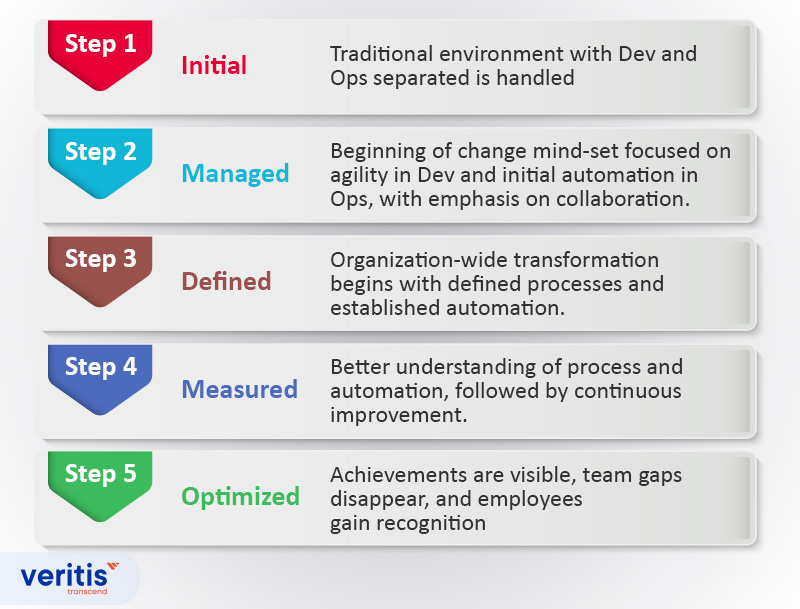
1) Stage-1: Initial
The traditional environment, in which Dev and Ops are separated, is handled.
2) Stage-2: Managed
The beginning of the changing mindset focused on agility in Dev and initial automation in Ops, emphasizing collaboration.
3) Stage-3: Defined
Organization-wide transformation begins with defined processes and established automation.
4) Stage-4: Measured
A better understanding of process and automation, followed by continuous improvement.
5) Stage-5: Optimized
Achievements are visible, team gaps disappear, and employees gain recognition.
While these five stages make a complete DevOps maturity model, enterprises must keep checking their maturity at every step and eventually identify focus areas and ways to evolve in the overall journey.
Useful link: AIOPS Solutions: Enhancing DevOps with Intelligent Automation for Optimized IT Operations
DevOps Maturity Model: Evaluate Your Current Status and Monitor Progress for Targeted Enhancements
Organizations can utilize the DevOps Maturity Model to gauge their existing state and pinpoint areas that require enhancement. This model also serves as a tracking tool to monitor their advancement as they embrace DevOps lifecycle principles and practices.
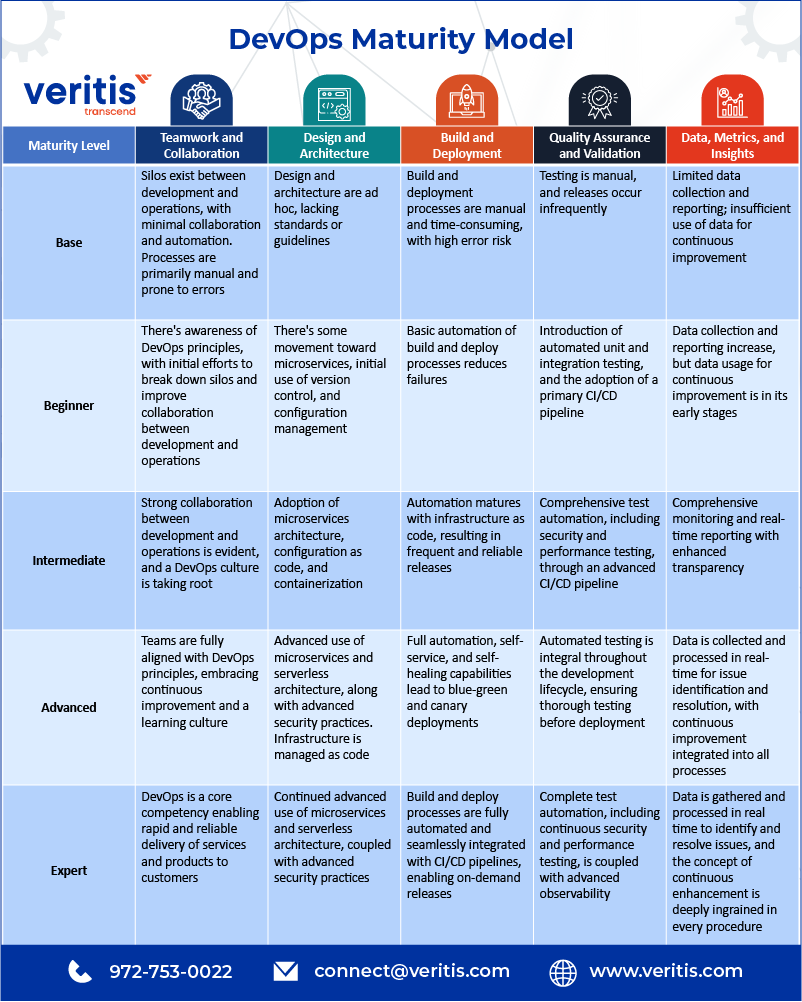
What to Measure in a DevOps Maturity Model?
A set of parameters must be measured at every stage of the DevOps Maturity Model to confirm an organization’s level of DevOps maturity. These measures ideally define the direction the organization is advancing in its DevOps implementation journey. They are:
- The number of completed projects and the release frequency should ideally be high, resulting in ROI
- The percentage of successful deployments should maintain an edge over unsuccessful ones
- Mean Time To Recovery (MTTR) from an unexpected incident/failure from the time of occurrence should be nil or as low as possible
- Lead time, from development of code to deployment in production, should be satisfactory
- Deployment frequency to determine the frequency of new code deployments
The stage-wise process and the above parameters define an organization’s DevOps maturity success.
Useful link: Building a High-Performing DevOps Culture: Strategies and Best Practices for CEOs and CTOs
DevOps Maturity Model Linked to Security

The DevOps maturity model is directly linked to DevOps security. As organizations progress in the DevOps automation journey, the competitive edge becomes a pressing demand calling for faster release cycles, and digital innovation demands a strong pitch. Development, operations, and security are the three words that make up the DevOps security concept. The objective of this agile development process is to eliminate any barriers that might exist between IT operations and software development.
This is where the security challenge starts becoming more serious, which is why DevOps culture calls for reconsidering security practices. Eventually, organizations must make security an integral part of their DevOps lifecycle process and take it closer to all application development stages. DevOps experts work with security personnel for early security integration at the maturity level across all parts of the Software Development Lifecycle. This can happen through effective DevSecOps implementation. Solutions like Containerization can also help to some extent in addressing issues continuously by limiting vulnerable resources.
Moreover, security and DevOps teams can collaborate to apply security policies and frameworks to all the DevOps tools and resources.
Useful link: Veritis Bags the CIO Review Award for Its Exceptional DevOps Solutions
Business Benefits of DevOps Maturity Model

Giving a complete picture of an organization’s DevOps team standing, the DevOps maturity model presents a wide range of business benefits:
1) Faster Adaptability to Change
DevOps principles allow organizations to adapt quickly to changing market conditions and customer requirements. Continuous integration and continuous deployment (CI/CD) pipelines enable rapid iteration and deployment of new features, enabling businesses to stay agile and responsive.
2) Ability to Tap Opportunities
Organizations with a mature DevOps practice are better positioned to capitalize on new opportunities. The ability to deploy updates and new services swiftly allows companies to launch innovative products and enter new markets faster than competitors.
3) Identifying Areas of Fulfilment
The DevOps Maturity Model helps organizations identify and address areas where their processes may be lacking. By continuously measuring and evaluating their practices, businesses can pinpoint inefficiencies and implement targeted improvements to enhance overall performance.
4) Improved Scalability
Mature DevOps practices facilitate the seamless scaling of applications and infrastructure. Automated provisioning and management of resources through Infrastructure as Code (IaC) ensure that businesses can handle increased loads and expand their operations without significant manual intervention.
5) Operational Efficiency
DevOps advocates automating repetitive tasks and breaking down barriers between development and operations teams. This leads to streamlined workflows, reduced manual errors, and more efficient resource use, ultimately lowering operational costs.
6) Increased Delivery Speeds
Organizations can notably shorten the delivery time for new features and updates by implementing automated testing, integration, and deployment. Faster delivery speeds enhance customer satisfaction and allow businesses to stay competitive in fast-paced markets.
7) Enhanced Quality
Continuous monitoring and feedback loops in mature DevOps practices ensure that issues are detected and resolved early in development. This leads to higher-quality software with fewer bugs and vulnerabilities, improving the overall user experience and reducing maintenance costs.
The DevOps Maturity Model thus provides a strategic framework for organizations to systematically enhance their DevOps practices, driving significant business benefits and ensuring sustained competitive advantage.
The maturity model includes more such benefits of DevOps, which allows you to witness its full potential.
Useful link: Demystifying MLOps vs DevOps: Understanding the Key Differences
DevOps Best Practices

Switching to DevOps offers numerous advantages. DevOps challenges won’t be entirely new despite having innovative approaches to improve the processes. The following are some of the DevOps best practices
1) Collaborating Teams
- Description: This practice emphasizes breaking down the traditional silos between development, operations, and other relevant teams. It encourages effective communication, shared responsibilities, and cross-functional collaboration to streamline the software delivery process.
- Benefits: Enhanced transparency, faster feedback loops, and improved problem-solving capabilities, leading to more efficient and reliable software delivery.
2) Continuous Integration (CI)
- Description: CI constantly integrates code changes into a shared repository, allowing automated builds and tests to validate each integration. This ensures multiple developers’ work is regularly merged, minimizing integration issues.
- Benefits: Early defect detection, faster identification and resolution of integration errors, and increased confidence in the quality of the codebase.
3) Continuous Deployment (CD)
- Description: CD focuses on automating the deployment, testing, and delivery processes, allowing rapid and reliable deployment of code changes to production.
- Benefits: Accelerated time-to-market, reduced deployment failures, and enhanced agility in responding to changing business requirements.
4) Continuous Testing
- Description: Continuous testing entails automatically running various tests at different stages of the software development lifecycle to verify the application’s performance, security, and functionality.
- Benefits: Early defect detection, improved code quality, and minimized risk of releasing faulty software into production environments.
5) Customer Satisfaction
- Description: This best practice underscores the importance of developing a customer-centric mindset and aligning DevOps efforts with customer needs and expectations.
- Benefits: Increased customer loyalty, higher user satisfaction, and a stronger competitive position in the market.
6) Effective Leadership
- Description: Effective leadership within DevOps teams fosters a culture of trust, innovation, and continuous improvement. It involves empowering team members, promoting collaboration, and aligning the team’s efforts with organizational goals.
- Benefits: Higher team morale, improved problem-solving capabilities, and sustained motivation to achieve shared objectives.
7) Effective Tools
- Description: Utilizing suitable tools for automation, monitoring, configuration management, and collaboration is crucial for streamlining and enhancing DevOps processes.
- Benefits: Increased operational efficiency, enhanced visibility into the software delivery pipeline, and improved decision-making based on real-time data and insights.
These best practices collectively contribute to the successful adoption and implementation of DevOps, leading to increased efficiency, higher software quality, and improved business outcomes.
In Conclusion
Businesses must remember that DevOps automation is a long-term commitment and not an overnight procedure as they progress in their DevOps transformation journey. DevOps Maturity model increases your overall organizational workflow, enhances release frequency, and minimizes time-to-market, thus giving you a competitive edge! Want to witness the full DevOps potential through the DevOps Maturity Model? ‘Explore Veritis, the Stevie Awards winner for DevOps Consulting services.
Got Questions? Schedule A Call
[WPSM_AC id=13925]
Related Posts:
- DevOps Adoption and Transformation: Approach, Best Practices and Business Benefits!
- 3 Factors That Decide Organizational Readiness to DevOps Adoption
- DevOps Configuration Management: A Guide to the Top Tools in the Field
- DevOps for AI: Make AI Operationalization a Core Business Objective!
- How Containers Can Boost Your DevOps Journey?
- DevOps Implementation in Manufacturing Sector: Meet the Culture-Driven Approach!
- Measuring DevOps: Key ‘Metrics’ and ‘KPIs’ That Drive Success!